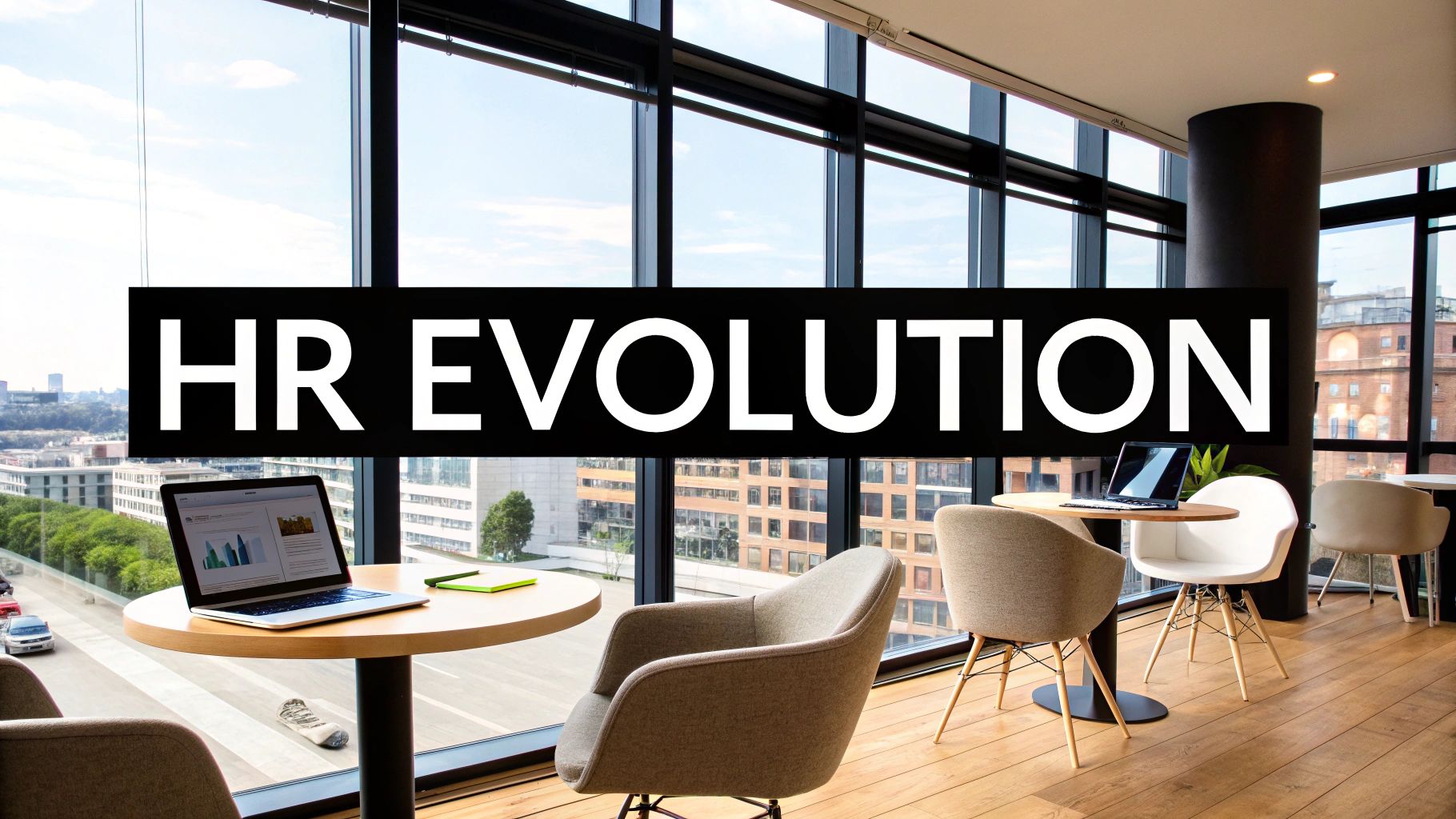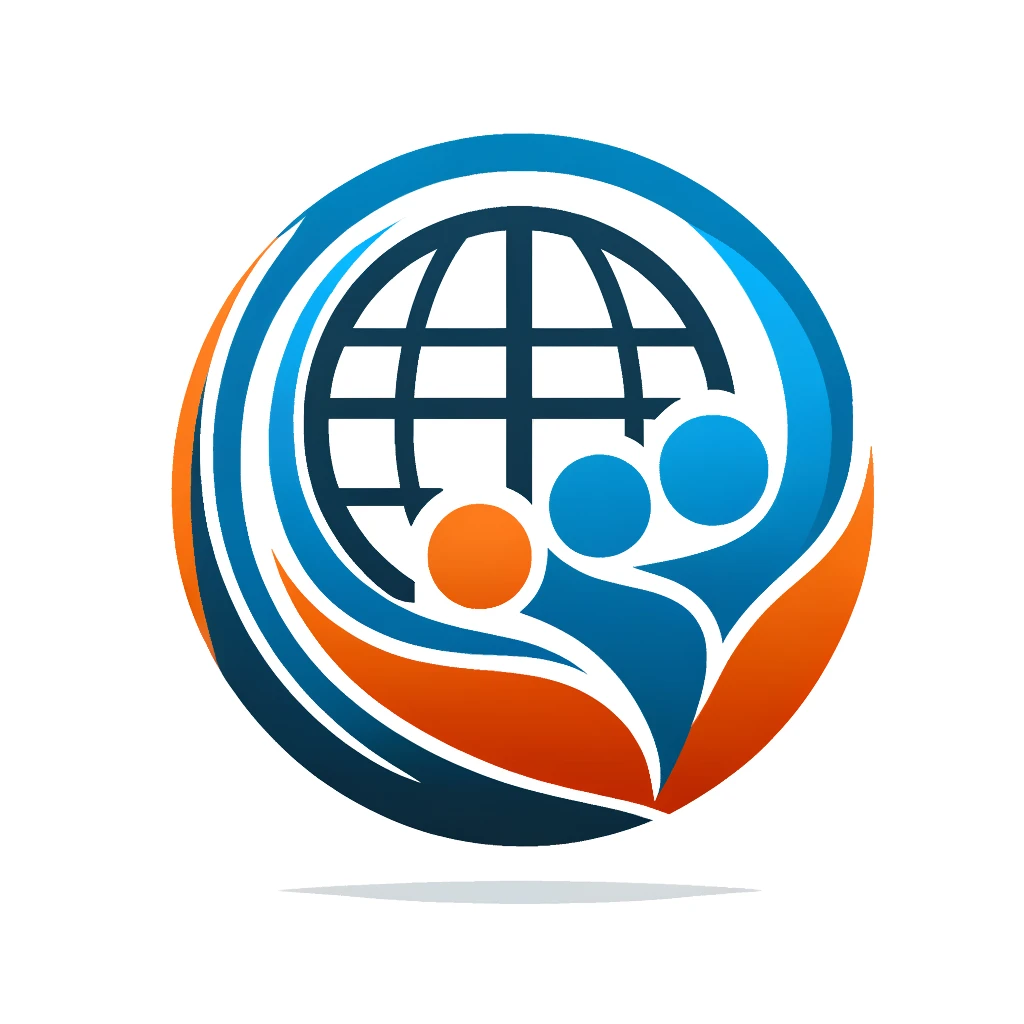The New Era of HR Digital Transformation

The Human Resources field is evolving. It's shifting from simply managing administrative tasks to becoming a core driver of business value. This exciting change is powered by HR digital transformation, which means using technology to rethink and reshape HR processes. It's not just about automating what we already do. It's about fundamentally changing how HR works and contributes to an organization's overall success. This puts HR in a powerful position to shape the future of work.
The Impact of Disruption
The global pandemic served as a powerful accelerator for digital tools and strategies across all industries, including HR. This rapid change compressed years of technological advancement into a much shorter time. Think about how many organizations suddenly had to embrace remote work. This required new ways of communicating, collaborating, and managing performance. This rapid shift highlighted how important digital HR is for business continuity and supporting a dispersed workforce.
It also prompted a reassessment of HR's role, with leaders recognizing its strategic importance in navigating unforeseen difficulties. The pandemic showed us the critical need for adaptable and agile HR practices. Organizations that had already started their digital transformation journey were better prepared for the sudden changes and maintaining employee engagement.
Those who hadn't prioritized digital HR struggled more with the transition to remote work, employee well-being, and maintaining productivity. This experience solidified the idea that HR digital transformation isn't just a passing trend, but essential for organizations to thrive in a world of constant change. In fact, this acceleration significantly impacted Digital HR maturity. Between 2020 and the end of 2022, Digital HR maturity increased by 4.9%, effectively fast-forwarding digital adoption by at least seven years. This growth was fueled by a growing understanding of the importance of digital strategies in people management, increasing from 49% to 63% of organizations. You can find more detailed information at AIHR.
Redefining HR's Strategic Value
This new era of HR digital transformation empowers HR professionals to go beyond traditional administrative tasks and focus on more strategic initiatives. By automating routine processes like payroll and benefits, HR teams can dedicate more time and resources to vital areas such as talent acquisition, employee development, and workforce planning. This positions HR as a true strategic partner, directly contributing to the organization's overall goals and bottom line.
This shift is crucial for organizations looking to gain a competitive edge. The ability to attract, retain, and develop top talent depends more and more on embracing digital HR strategies. This evolution is all about building a more resilient, adaptable, and people-focused organization that can navigate future challenges and seize new opportunities.
Game-Changing Technologies Reshaping HR Functions

The shift towards a strategic HR function is exciting. Powerful technologies are fundamentally changing how HR operates, creating entirely new possibilities. This empowers HR to focus on driving real business value. But which technologies are truly making a difference in this evolution of HR?
AI-Powered Talent Acquisition
Talent acquisition is one area experiencing a significant shift. AI-powered platforms analyze massive amounts of data to identify ideal candidates faster than ever before. Some platforms report a 60% reduction in hiring time through features like intelligent candidate matching and automated screening. These advancements save time and help reduce bias in hiring decisions.
Revolutionizing Employee Experience with Technology
Employee experience is another area ripe for positive change. Dedicated platforms now gather and analyze employee feedback in real time, allowing HR to identify and address pain points proactively. These systems can also personalize the employee journey, from onboarding to development, boosting engagement and retention. This empowers HR to shift from reactive problem-solving to proactive experience enhancement.
To understand the impact of these technologies, let's look at a comparison of some key HR digital tools. The following table highlights their primary functions, implementation complexity, potential ROI, and typical adoption timeline.
HR Digital Technology Comparison
| Technology Type | Primary Function | Implementation Complexity | ROI Potential | Adoption Timeline |
|---|---|---|---|---|
| AI-Powered Recruiting Software | Automates candidate sourcing, screening, and matching | Moderate to High | High (reduced time-to-hire, improved quality of hire) | 12-18 months |
| Employee Experience Platforms | Collects and analyzes employee feedback, enables personalized experiences | Moderate | Medium to High (increased engagement, reduced turnover) | 6-12 months |
| Learning Management Systems (LMS) | Delivers and tracks employee training and development | Low to Moderate | Medium (improved skills, increased productivity) | 3-6 months |
| HR Analytics Dashboards | Provides data-driven insights into HR metrics and trends | Low to Moderate | Medium to High (improved decision-making, optimized HR processes) | 6-12 months |
| Core HR Systems (HRIS/HCM) | Manages employee data, payroll, benefits, and other core HR functions | High | Medium (improved efficiency, reduced administrative costs) | 18-24 months |
As this table illustrates, different HR technologies offer varying levels of impact and require different implementation approaches. Choosing the right mix for your organization is crucial for success.
Building Integrated Digital Ecosystems
The true power of this shift lies in building an integrated ecosystem. Connecting different technologies allows them to work together seamlessly, creating a unified and efficient HR function. Integrating performance management data with learning platforms, for example, can personalize development recommendations. This interconnectedness maximizes the impact of each technology.
Choosing the Right Technologies for Your Organization
Not every technology is a good fit for every organization. Carefully evaluate which tools align with your specific challenges and goals. A practical framework includes assessing current processes, identifying pain points, and researching solutions that directly address those areas. This focused approach ensures that technology investments contribute to organizational goals and maximizes the return on investment. This targeted approach is essential for long-term success.
Mastering Remote and Hybrid Workforce Management

The world of work has changed. The distributed workforce, encompassing both remote and hybrid models, is here to stay. This new reality presents both exciting opportunities and unique challenges for HR departments. It calls for a fresh perspective on how we support teams spread across various locations.
Digital Tools For A Seamless Employee Experience
Successfully navigating this shift requires the right digital tools. These tools should create a seamless experience for every employee, from their first day to their retirement. This means integrated systems, not just a collection of separate platforms.
A robust HRIS system, for instance, can connect performance data with learning platforms, personalizing development and simplifying workflows. This integrated approach empowers employees and streamlines HR processes.
Maintaining Connection and Culture In A Virtual World
One of the biggest hurdles in managing a remote/hybrid workforce is maintaining a strong company culture. How do we keep everyone connected and engaged when they’re not physically together? Technology provides the answer.
- Virtual team-building activities: These can range from online games to collaborative projects, fostering camaraderie and team spirit.
- Online social platforms: Dedicated platforms can help employees connect informally, sharing updates and building relationships.
- Regular video conferencing: Face-to-face interaction, even virtual, helps maintain a sense of connection and strengthens team bonds.
These strategies, when implemented thoughtfully, can bridge the physical distance and create a thriving virtual community.
By 2025, HR leaders are predicted to prioritize the automation of workflows to improve efficiency, boost the employee experience, and cut administrative costs. Learn more about these trends in HR digital transformation here. As companies increasingly rely on technology, it's crucial to understand relevant policies, such as Ontario's mandatory electronic monitoring policy. Staying informed ensures compliance and builds trust with employees.
Virtual Onboarding And Digital Performance Management
Bringing new hires on board virtually demands a new approach. Digital onboarding tools offer structured learning, virtual introductions to colleagues, and easy access to company resources.
Similarly, digital performance management tools allow for ongoing feedback, goal setting, and performance reviews, regardless of location. This emphasis on clear expectations and consistent communication is essential for a productive distributed team.
Technology-Enabled Collaboration and Human Connection
While technology is essential, it’s vital to balance digital efficiency with genuine human connection. HR leaders should promote tools that facilitate collaboration but also create opportunities for authentic interaction.
Think virtual coffee breaks, online social events, or simply encouraging team members to connect personally. This balanced approach is crucial for a positive and productive work environment. By embracing both technology and human connection, HR can successfully navigate the complexities of the modern workplace.
Harnessing AI and Automation Without Losing Humanity

AI and automation are changing the HR world, creating a wealth of new opportunities. These technologies go beyond simply making current processes faster. They redefine what’s possible in HR. The key is finding the sweet spot: maximizing the power of digital tools while keeping the essential human touch alive within HR.
Automating for Efficiency and Strategic Focus
Some HR tasks are ideally suited for automation. Think of repetitive, time-consuming processes like payroll, benefits administration, and even parts of recruitment. Automating these functions not only frees HR professionals from tedious tasks, it also reduces errors and allows for a more strategic approach.
Imagine the possibilities. Automating candidate screening, for example, can save countless hours and empower recruiters to focus on building relationships with top talent. This shift toward automation allows HR to focus on what truly matters: the people.
Where AI Excels: Data-Driven Decisions
AI brings its own unique strengths to HR, especially when it comes to analyzing data and recognizing patterns. AI-powered tools can sift through mountains of information to identify potential flight risks and predict future talent needs. Some AI solutions can even help reduce bias in hiring.
This data-driven approach equips HR teams to make smarter, more strategic decisions. It's about moving beyond intuition and embracing the power of evidence-based decision-making.
The Human Touch: Preserving Meaningful Connections
While AI and automation offer undeniable advantages, certain HR functions thrive on a human-centered approach. Building trust with employees, coaching team members, and navigating sensitive situations require empathy, emotional intelligence, and nuanced communication. These are uniquely human qualities.
This means areas like employee relations and leadership development should remain deeply personal, prioritizing connection and understanding.
To illustrate the benefits, consider the data in the table below. It demonstrates how automation can be used efficiently for certain tasks to maximize the impact of human input for other parts of the HR process.
The table below shows the impact of HR Process Automation. It provides a statistical breakdown of how automation affects different HR processes.
| HR Process | Manual Time Required | Automated Time Required | Efficiency Gain | Cost Reduction |
|---|---|---|---|---|
| Onboarding | 4 hours | 1 hour | 75% | 60% |
| Payroll | 8 hours | 0.5 hours | 94% | 80% |
| Recruitment Screening | 6 hours | 1.5 hours | 75% | 50% |
| Benefits Administration | 2 hours | 0.25 hours | 88% | 70% |
| Performance Reviews | 3 hours | 1 hour | 67% | 40% |
As this table illustrates, automation can significantly reduce the time and cost associated with key HR processes. The time saved allows HR professionals to dedicate their expertise to more strategic initiatives and interpersonal interactions that benefit employees and the organization.
Practical Applications Across the Employee Lifecycle
AI and automation are transforming the entire employee lifecycle. From intelligent candidate matching that streamlines recruitment to personalized learning platforms that enhance employee development, the possibilities are endless.
Predictive analytics, for instance, can help identify potential issues before they escalate. This proactive approach allows HR to offer timely support and address concerns, fostering a more positive and supportive work environment.
Balancing Technology with Human Connection
Ultimately, the key to success lies in striking the right balance. It’s about strategically integrating AI and automation to boost efficiency and improve decision-making, all while preserving the human elements that foster a positive and meaningful employee experience.
This balanced approach ensures HR remains a driving force behind both organizational success and employee well-being. The future of HR is human and digital, working together in harmony.
Crafting Your HR Digital Transformation Roadmap
Successful HR digital transformation is more than just finding the right software. It's about envisioning a better future for your workforce, creating a solid plan, and executing it with precision. This section provides a practical framework for designing your organization's unique path, inspired by companies who've successfully made similar changes.
Building a Compelling Business Case
Getting your executives on board is crucial. A strong business case clearly explains the why of your transformation. It should highlight the challenges HR currently faces, the potential advantages of digital solutions, and the expected return on investment (ROI). Show how digital tools can cut costs, boost efficiency, and create a better employee experience. This justifies the resources and positions HR as a strategic partner for growth.
Phased Implementation for Early Wins
A step-by-step approach is often better than a complete system overhaul. Start with a pilot project in one specific area, such as talent acquisition or performance management. This allows for controlled testing and the chance to achieve quick, demonstrable results. These early wins build momentum and showcase the value of the larger transformation initiative. This iterative process minimizes disruption and allows you to adapt based on real feedback.
Cross-Functional Partnerships for Seamless Adoption
HR digital transformation affects everyone in your organization. Strong partnerships with other departments, especially IT, are essential. This collaboration ensures new technologies integrate seamlessly with existing systems, aligning with overall business goals. This collaborative approach fosters shared responsibility and increases the likelihood of successful adoption.
Digital transformation in HR reflects a wider business trend. By 2023, global investment in digital transformation was projected to reach $7 trillion, showing a significant shift towards digitally mature organizations. The increasing use of technology, accelerated by the pandemic, has reshaped the workplace, particularly with the rise of hybrid work models. You can find more detailed statistics here: myhubintranet.com.
Defining Meaningful Metrics
Measuring progress is key. Concentrate on metrics tied to business outcomes, such as reduced time-to-hire, improved employee retention, and increased employee engagement. These metrics demonstrate the transformation’s tangible impact and support continued investment.
Navigating Resistance to Change
Change can be difficult, and resistance is expected. Open communication, thorough training, and ongoing support are crucial for winning over those who are hesitant. Clearly explain the transformation's benefits and address any concerns proactively. Transparency builds trust and makes the transition smoother.
Bringing It All Together: Your Transformation Journey
Creating an HR digital transformation roadmap is a complex but fulfilling process. By focusing on a clear vision, phased implementation, cross-functional collaboration, and meaningful metrics, HR can lead the way in building a future-ready workforce. Position HR as a strategic partner, driving organizational success. This journey is more than just technology; it's about empowering HR to deliver greater value to both employees and the business as a whole.
Measuring What Matters: Proving HR Transformation ROI
Successfully transforming HR in the digital age means showcasing its real impact on the business. This goes beyond surface-level metrics and dives into measurements that genuinely reflect value. How can you demonstrate that your HR tech investments are truly making a difference? It's all about linking people metrics to measurable business outcomes.
Beyond Vanity Metrics: Focusing on Business Impact
Many traditional HR metrics, such as training hours completed or cost-per-hire, don't provide the complete picture. While important, these metrics aren't always connected to better business performance.
Instead, focus on outcomes that directly influence the organization's bottom line. For example, consider measuring how training impacts employee productivity or the correlation between employee and customer satisfaction. This shift in perspective directly ties HR initiatives to tangible business value.
Developing Balanced Scorecards: Connecting People and Business
Balanced scorecards provide one effective method. These tools combine different key performance indicators (KPIs) to give a comprehensive overview of HR's contribution to the business.
A balanced scorecard might include metrics related to employee engagement, talent acquisition, learning and development, and operational efficiency. It's crucial that these metrics are directly linked to overarching business goals like revenue growth, customer retention, and market share. This connection clearly shows how HR is influencing the overall success of the organization.
Measuring Quantitative and Qualitative Improvements
Demonstrating ROI for HR digital transformation demands considering both quantitative and qualitative information.
-
Quantitative benefits: These are generally easier to measure and may include cost savings from automation, faster time-to-hire, or fewer errors in payroll. Automating onboarding, for example, can lead to significant cost reductions and quicker integration of new hires.
-
Qualitative improvements: More subtle, but no less critical, these could include improved employee morale, enhanced managerial effectiveness, or increased organizational agility. Though sometimes difficult to quantify, these factors significantly influence long-term performance and employee satisfaction.
Telling Compelling Stories with Data: Digital Dashboards
Today's HR departments are using digital dashboards to visualize key metrics and present data clearly and persuasively. These dashboards can monitor progress towards objectives, pinpoint areas needing improvement, and showcase the effectiveness of HR initiatives.
They transform raw data into actionable insights, enabling HR to tell powerful stories about their contribution to the business. This change in presentation helps shift the perception of HR from a cost center to a strategic driver of value. This justifies ongoing investment in HR technology and positions HR as a key partner in achieving organizational goals.
For those looking to advance their HR careers and gain a competitive advantage, the Global Human Resource Institute offers various certifications, including HRQP, HRAP, and HRCE. These programs offer practical knowledge and innovative learning approaches covering essential HR topics. Explore the institute’s programs and discover how they can empower your HR journey.




0 Comments